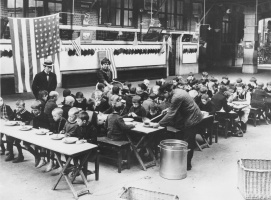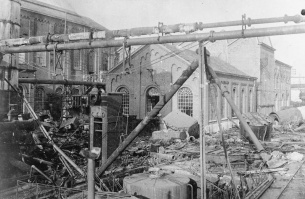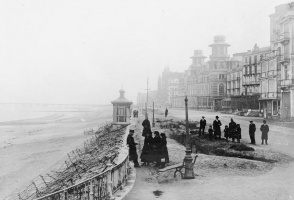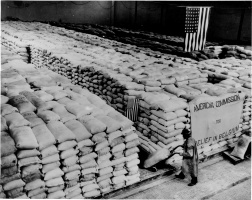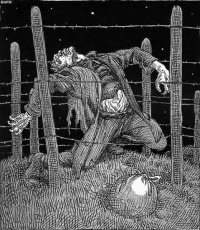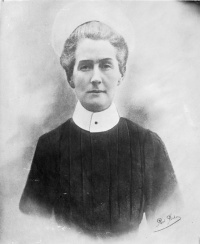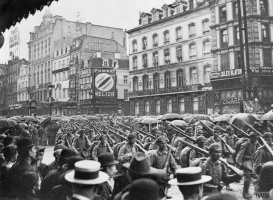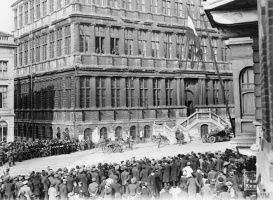Introduction↑
Neither the occupation of Belgium nor the occupation of French territory was planned long beforehand. Both were more or less a consequence of the failed execution of the so-called Schlieffenplan. Germany had invaded Belgium thus violating its neutral status, because it wanted to avoid the French fortresses between Belfort and Verdun. The occupation of French territory on the other hand was a result of the Battle of the Marne, in the course of which French troops stopped the German advance. When in November 1914 the race to the sea ended in the stalemate of trench warfare, 3.7 percent of the French territory remained in the hands of the German army.
Not only the brutal invasion, during which German troops killed more than 6,000 civilians and burned several villages in retaliation for alleged partisan warfare, but also the German occupation practices and policies caused massive protests from Allied and neutral countries. They also had a considerable influence on the paragraphs of the Versailles Treaty concerning German war guilt. In the interwar period, both the occupation of Belgium and France remained much discussed in literature and the press. After the Second World War, though, the occupations, particularly that of France, faded into obscurity in view of the horrors of the Second World War, and was only rediscovered by historians in the 1990s. Today, there exists a good, though not vast, variety of historiographical works on both occupations.[1]
Several of these studies are based on the concept of total war and the effects it had on the civil population.[2] They generally proceed from the thesis that the totalization of warfare since the late 19th century resulted in the increasing involvement of civilians in the prosecution of war, which was both calculated and systematic, and had disastrous consequences. There is a widespread consensus that the situation for civilians was particularly precarious in occupied territories. Indeed, especially in these areas two decisive characteristics of the First World War led to a fatal dynamic: not only was this conflict an economic war of unprecedented extent,[3] but also it was fought as a defensive, or even existential, war by all sides, which entailed a hitherto unknown mobilization of the participants’ societies. The occupation practices and policies were altogether determined by the alleged or actual constraints of economic warfare, which led the occupier to exploit the resources of the occupied territories as much as possible. At the same time, the uncompromising character of this war and the mental mobilization of the home front rendered the occupied population overall reluctant to cooperate with the occupier, who generally responded with force. Hence, the relations between occupier and population were marked by a fatal spiral of reaction and counter reaction.
Economic war and occupation↑
There was a long-term and a short-term dimension to the economic side of the First World War. The long-term dimension related to the post-war order. Although, like the other belligerents, Germany entered the war without concrete war aims, there was a broad consensus among the German political and intellectual elite that Germany would play a leading role in Europe after the war. Plans however differed as to extent and way of achieving this aim. While the political right called for extensive annexations, more moderate circles advocated for forms of indirect rule in Europe.[4] The short-term dimension of the economic war consisted in the realization that only that side would win the war which had the most resources, both of men and raw materials, at its disposal. In Germany, which was cut off from the global market by Britain’s North Sea blockade from August 1914, the economic potential of the occupied territories was soon realized and measures taken to exploit them for the German war effort. Hence, both the long-term and the short-term economic dimension of the First World War directly affected the German occupation policy. Yet, the long-term plans for economic leadership in Europe were soon competing with the policy of short-term economic exploitation to sustain the war effort. This led to an often contradictory occupation policy, particularly in Belgium.
Belgium: Between long-term planning and short-term economic exploitation↑
While there was widespread agreement that Belgium should become a politically and economically dependent vassal state to Germany, the most radical German long-term plans for Belgium wanted its complete annexation. In August 1914 a General government of Belgium was established with a military governor at its head. The General Governor was not only responsible for administering the occupied territory during the war, but he was also supposed to lay the ground for a post-war order that would tie Belgium closely and permanently to the Empire.
Apart from the economic penetration of Belgium, which aimed at the long-term utilization and exploitation of its industries for Germany, the so-called Flemish policy became a major concern for the future-oriented occupation policy.[5] The German government had the, initially, rather vague hope to win over the Flemish population of Belgium by supporting Flemish activist groups, who had been at a constant quarrel with the Belgian government before the war, fighting for more rights and the recognition of Flemish culture and language emancipation.[6] The German Flemish policy reached a climax in 1916, when the occupier reopened the University of Ghent as an exclusively Flemish-speaking institute, and culminated in the administrative splitting of Belgium into the two separate regions of Flanders and Wallonia in March 1917. This step was not only aimed at the Flemish population, but was also meant as an incentive for the Walloon movement, which the German occupiers very irrationally hoped to convince of their cause too by promising close post-war ties between an independent Wallonia and Germany.
Ultimately, the occupying power’s efforts to take advantage of the inner conflict of the Belgian state failed completely. Rather than driving a wedge between Walloons and Flemings it primarily caused discord within the Flemish movement and ultimately resulted in the majority of Belgians unifying behind their nation.[7] Moreover, whatever long-term plans Germany had concerning Belgium in cultural and economic terms, they were torpedoed by an occupation policy which increasingly resorted to short-term economic exploitation. This trend prevailed under the Third Supreme Army Command of Paul von Hindenburg (1847-1934) and Erich Ludendorff (1865-1937), who demanded a ruthless exploitation, not only of raw materials, but also of manpower.
Particularly counterproductive to the Germans’ cultural long-term policy were their attempts to solve the so-called "labour question" (Arbeiterfrage), that is, Germany’s excessive demand for labour and the high unemployment rate in Belgium, which led to compulsory labour and deportations. As industrialized warfare caused massive losses, more and more soldiers were needed at the front. To fill the shortfall in manpower in the German war industry, leading industrialists demanded workers from the occupied territories to sustain the German war effort.[8] However, in Belgium, where a high percentage of the industrial labour force was unemployed, attempts at a large-scale recruitment of voluntary workers failed. Against the express will of General Governor Moritz von Bissing (1844-1917), who feared further unrest among the population, but under the combined pressure of the Third Supreme Command, heavy industry and Prussian War Ministry, forced deportations of unemployed Belgian workmen were started in autumn 1916.[9] From October 1916 to February 1917 around 60,000 Belgians were deported to Germany for work in the German war economy. This drastic measure was stopped in early 1917 after massive protests from allied and neutral countries – and when it failed to be efficient.[10]
In other respects, the short-term exploitation of Belgium prevailed over intentions to profit from its economy in the long run. Already at the beginning of the war, many Belgian industries had to cease production due to large-scale confiscation of raw materials by the occupier. By the second half of the war, factories not serving German interests were shut down and many of them were dismantled and their stocks and machines brought to Germany.[11]
France: Supplying the German army and relieving the home front↑
Long-term plans for the role of France in a German-dominated post-war Europe were considerably more vague than those for Belgium. Although Pan-German fantasies called for the annexation of French territory as far as the estuary of the river Somme, the war aims of the German government primarily envisaged the ore basins of Longwy and Briey. Apart from that, France was to be militarily defeated and then integrated into the European post-war order under German leadership.[12] These long-terms plans however did not decisively affect the German occupation policy during the war. Rather, from the beginning, the occupied territories of North-Eastern France were subjugated to a radical policy of short-term economic exploitation.
This short-term exploitation was two-fold. As the French territory remained an operational- and rear area until the end of the war and thus under the control of the German army, it was exposed to extensive requisitioning by German troops, who increasingly lived off the land. Yet, extensive economic exploitation of the occupied French territories for the German war effort was also in the utmost interest of the German government. The occupied French territory comprised one of the most important industrial regions of France, which conventiently assisted Germany, as the British sea blockade soon deprived it of many of its basic necessities.
In order to relieve the German war economy, more and more raw materials and machines were seized in occupied France and brought to Germany. At first, these measures primarily concerned stocks and supplies of local factories, but later on also private persons had to support the German war effort, for example by delivering all household items made of copper and other metals needed for war production; a provision that had already been introduced in Germany itself. From 1916 onwards the local population (as well as the German military staff) were even stripped of the wool stuffing from their mattresses, and finally even church bells were removed to be melted down for weapons.[13]
Moreover, in the occupied French territory, as well as in the Belgian operational- and rear area, the military authorities resorted to compulsory labour from the very beginning. In these areas, forced labour was initially a consequence of purely military logics. Referring to article 52 of The Hague Convention – which codified the customary law that the army of occupation could demand goods and services from the inhabitants of an occupied territory for its needs[14] – the military authorities expected the local population to execute work in their interest. When people refused to work for them, this, in the military’s opinion, violated international and customary law and authorized sanctions. From here developed a system of forced labour, which became increasingly methodical over the course of the war. While initially labour was generally restricted to works for the immediate needs of the occupation troops, it soon became linked to the economic situation of Germany and the effects of the war of attrition, which this conflict had turned into.
As the occupied territories’ harvests were to compensate for the food shortage in Germany caused by the British blockade, the German occupation authorities had a growing demand for agricultural workers. At the same time, local civilians were to replace soldiers in various other work fields behind the front line, often work traditionally carried out by pioneer units, such as road building, woodcutting or even construction of fortifications. The military authorities constantly tried to recruit workers voluntarily, since they thought that "voluntary work" (which could of course no longer exist after force had once been introduced) was generally more effective. Moreover, article 52 of The Hague Convention forbade forcing inhabitants of occupied territories to take part in military operations against their own country,[15] which arguably included the construction of fortifications. Hence, they established a very contradictory system of force and inducement, which did not meet with much success.
In 1916 compulsory labour finally prevailed as a general policy. After the Third Supreme Command came to power the infamous civil-workers battalions (Zivil-Arbeiter-Bataillone) were created in the operational- and rear zones.[16] These battalions were composed of men between sixteen and forty-five (later sixteen and sixty) who refused to work voluntarily for the occupier. Work in these battalions was hard and dangerous, food rations were poor, and the men were ill-equipped and badly accommodated. Moreover, from 1916/17 onwards, many of these forced labourers had to participate in the construction of huge defensive positions.[17] Despite incessant protests from allied and neutral sides, the military authorities maintained the system of compulsory labour until the end of the war.
In both Belgium and Northern France the economic exploitation of the occupied territory grew increasingly total over the course of the war. The German occupiers justified their measures mainly with the British blockade, hereby acting on the principle of reciprocity and claiming that the enemy population should not be better off than their own. All in all, the occupiers’ policy remained highly contradictory. Measures such as compulsory labour and deportations destroyed their already rather irrational efforts to win over the local population to the German cause. Ultimately, their economic warfare exacerbated the already existing tensions between occupiers and occupied.
Living with the enemy: Occupier/occupied-relations between conflict and cooperation↑
Many factors contributed to rendering the complex relations between occupier and occupied even more complicated. For one thing, 19th century nationalism created the mental and legal frameworks for hindering cooperation and agreement between both groups. The fin-de-siécle nation state expected unconditional loyalty and patriotism from its citizens. In the course of the 19th century, many of the belligerent states had introduced laws penalizing the crime of treason, among them France and Germany. Others, such as Belgium, followed during the war. For the inhabitants of the occupied territories this caused a dilemma: If they offered resistance to the occupier they would be punished, if they cooperated too readily they risked to be prosecuted by their own government after the war.[18] At the same time the First World War entailed a propaganda campaign of an unprecedented dimension. Each belligerent government tried to strengthen its population’s enthusiasm for war by creating strong representations of the enemy.
The allied propaganda was especially effective, not least because Germany had discredited itself through the brutal invasion of Belgium and France.[19] It was indeed the violence of the first weeks that substantially shaped the occupied population’s perception of the invader. Yet the representation of the enemy intertwined actual experiences with the memory of 1870/71 or even older conflicts. Notably in France, this led to a reactivation of traditional stereotypes, of which the crude and lawless barbarian – omnipresent in allied propaganda campaigns – was only the most common example.[20]
Some German concepts of the enemy on the other hand can likewise be traced back at least to the Franco-Prussian War. Especially powerful and destructive was their persuasion that they were facing a people’s war in Belgium and France, and that partisans, the so-called francs-tireurs, were waging an irregular warfare against their troops.[21] This fixed idea, which mostly arose from "mass delusion",[22] was the main reason for the German army’s excesses in the course of their advance. Although this concrete fear of partisans had disappeared during the actual occupation, the occupiers remained in a state of tension, always dreading hostile acts from the local population. Yet, rather than being a direct cause of the imagined guerrilla warfare, this general feeling of insecurity seems to have been part of a bigger paranoia, that is the firm belief – shared by many Germans – that Germany was surrounded by enemies and waging a war of defence (albeit preventive).[23] This putative self-defence had a substantial influence on the occupiers’ treatment of the enemy population, as it led to the priority of the principle of military necessity, which ultimately subordinated the needs and claims of the civilians to the war effort.
Consequently, the relations between occupier and occupied were overall characterized by conflict and friction, which often led to passive and active acts of opposition on the part of the local civilians. However, there was also room for cooperation.
Passive and active resistance↑
From the beginning, inhabitants of the occupied territories offered passive and active resistance to the invader. The German authorities, in turn, first and foremost wanted peace and order in the rear-lines and expected the population to stay calm and obedient. In both Belgium and France they established a strict occupation regime that interfered severely with the local civilians’ daily routine. Especially in the operational- and rear area, where the maintenance of peace and order was of highest priority, the population had to submit to a particularly strict set of rules and prohibitions. Mobility was restricted, identity cards were introduced, curfews imposed, arms, carrier pigeons and telephones seized, postal traffic limited, newspapers censored or forbidden. Apart from such measures introduced for security reasons, there were other demands perceived as purely vexatious by the local population, such as orders to keep the streets clean, and especially the obligation to salute all German officers (the notorious Grußpflicht). While in military authority logic these measures were a way of re-establishing or ensuring order, respect and obedience of the enemy civilians where they felt it was lacking, they generally had the opposite effect. The flood of regulations only intensified the hostile attitude among the population.
Acts of passive resistance could comprise of refusal to work, or retaining or hiding goods the occupier claimed for requisitioning. Some people refused to interact or even talk to the German occupier, while attempts of the latter to show good will through organizing theatre plays and concerts open to the public were generally ignored. The overall dismissive or hostile attitude of the local population increased the constant feeling of a latent threat among the occupying forces. Also, as described above, the refusal to execute services in the military authorities' interest violated the Germans’ legal concept, while the resisting civilians invoked their respective national legislation on treason, or article 52 of the Hague Convention (where it was known).[24]
Active resistance on the other hand could consist of individual acts of violent opposition, which were often spontaneous reactions to orders or actions of the occupiers. There were also organised forms of resistance, though they never reached the dimensions of the Second World War.[25] Acts of sabotage were mainly directed by the Allies, who placed agents behind enemy lines to sabotage railways or communication cables. But there also existed widespread spy rings and resistance networks composed of local civilians.[26] Their activities ranged from an underground mail service and distribution of clandestine newspapers to informing the allied armies of German troop movements and helping allied soldiers stranded in the occupied areas to rejoin their armies. These networks included several women.[27]
Another influential source of resistance was the church. Especially the Archbishop of Mechelen, Cardinal Désiré-Joseph Mercier (1851-1926), was a most defiant clergyman, who became a symbol for Belgian patriotism and resistance. From the outset of the war, the Cardinal called upon the local population not to cooperate with the Germans. In the course of the war, he protested against several measures of the occupiers, particularly against the deportations of Belgian workers to Germany and compulsory labour in general.[28] In France, too, many local clergymen encouraged, or offered passive resistance, as for example the bishop of Lille, Alexis-Armand Charost (1860-1930).
Cases of resistance and espionage caused panic among the occupying forces and seemingly validated their suspicions of the local population. As a deterrent, acts of resistance were usually severely punished. The death penalty was imposed primarily for espionage, retaining of weapons or for aiding Allied soldiers. Executions were often carried out to make an example. Several times, though, especially towards the end of the war, death penalties were commuted into prison sentences. This notably happened in the case of female defendants, which was a consequence the German government had drawn after the execution of the British nurse Edith Cavell (1865-1915) in October 1915 had caused massive international protests.[29] Yet, the longer the war the more the occupier’s penal system was influenced by economic warfare. Instead of being sentenced to prison, more and more convicts were put into prisoners’ battalions (Strafgefangenen-Bataillone) where they were forced to execute work in German interest.[30]
Thus, while the German occupiers expected cooperation from the population, and, in case of default, tried to enforce it, this, in most cases only led to even more resistance. Yet, while some civilians bade defiance to the invader, others sooner or later adapted themselves to the circumstances.
Cooperation, collaboration, personal relationships↑
Despite constant friction between occupiers and occupied there were, from the beginning, also forms of cooperation or even collaboration.[31] The occupier naturally had a strong interest in cooperation with the local civilians. This especially applied to the French and Belgian authorities. In particular the mayors were indispensable intermediaries between occupying power and population. The local authorities on the other hand needed to cooperate with the invader in order to defend the interests of their communities. So, in the end, both sides had to find a modus vivendi.
One of the most acute issues to be solved together was the problem of food supply in occupied Belgium and France, where the local population soon suffered from deprivation. As the Germans wanted to avoid the burden of having to share their scarce resources with the occupied territories, but also feared hunger revolt, they accepted the intervention of private persons and neutral states. Already from November 1914 onwards the Commission for Relief in Belgium (CRB) delivered food to Belgium,[32] from early 1915 to Northern France.[33] In return, the German authorities pledged not to requisition the delivered goods. While particularly the British government had been reluctant to permit this kind of support for the population as it relieved Germany economically,[34] the German military authorities initially deprecated the CRB’s activities, too. For them, they constituted a safety risk as the Commission’s personnel gained access to the vulnerable rear zone.
In general, the local authorities often walked a fine line between complying with the occupier’s demands when they seemed halfway acceptable, while at the same time offering opposition against orders deemed unlawful so as to prevent the charge of treason by their own government after the war.[35]
The occupation authorities on the other hand made certain concessions to the needs and claims of the occupied. For instance, protests or appeals from local authorities or civilians were not merely rejected, but thoroughly verified and sometimes accepted. Furthermore, some members of the occupation administration on site raised objections against measures stipulated from above which they deemed ineffective or too radical, or found their own strategies for dealing with the population, which could involve the (partial) yielding to the needs of the civilians (or what they assumed to be their needs).
The occupation authorities’ readiness for concessions was however limited. Like many Germans, they seem to have been generally convinced of Germany’s self-defence, and that the British blockade justified a ruthless exploitation of the occupied territories. The modus vivendi therefore remained fragile. The local authorities were not to carry their protests too far otherwise they risked the imposition of fines for their community or even deportation.
While the mayors in general cooperated with the occupier to serve their community, other civilians collaborated with the enemy in pursuit of personal profit. The German authorities could for example rely on private persons, whom they recruited as so called confidential people (Vertrauensleute), who would spy on and denounce their compatriots. Others would let themselves be hired for propaganda purposes, and worked as writers for journals edited or controlled by the occupation authorities, such as La Belgique in Belgium or the Gazette des Ardennes in France. There were also borderline cases – for example business people who profited from the occupation by putting their companies into the occupier’s service, and in doing so served both the occupying power and the local population. This applied for instance to some coal mine owners and electricity companies.[36]
People who collaborated voluntarily with the occupier not only had to expect punishment by their own government after the war, but were often verbally and physically attacked by their compatriots.[37] Women who associated with German soldiers shared the same fate, not only when they entered romantic relationships, but also when their motivation was purely economical and/or caused by sheer need. Prostitution flourished within the occupied regions, a trend that filled the locals with disdain and the occupation authorities with growing unease. While the former deplored the continuing decline of morals for which they blamed the occupiers, the latter worried about the safety of their troops, even if prostitution was tolerated in principle. The occupation authorities were especially concerned about venereal diseases, which spread rapidly and threatened to put a significant number of German soldiers hors de combat.
In general the occupation authorities tried to prevent close contacts between soldiers and the inhabitants of the occupied regions, as they suspected spies everywhere. Personal relationships developed nonetheless. Evidence suggests that they usually formed along social class lines, as "simple soldiers" generally identified with working class members or peasants, and officers with members of the local elite. Among other things, such fraternisation could lead soldiers to share their scarce food with local civilians, or officers to try to save their billet hosts from requisitions. Romantic relationships also developed between German soldiers and local women, sometimes to the point that the soldiers asked their superiors’ permission for marriage, which had however little chance for success.[38]
Conclusion↑
For Germany, the occupied territories offered a convenient opportunity to get hold of urgently needed raw materials to sustain the war effort. From the beginning, the German occupiers proceeded rather unscrupulously in this regard, as they felt they were fighting a preventive war of defence, an idea which especially Britain’s North Sea blockade seemed to prove. The longer the war and the more economic factors threatened to become deciding, the more total the economic exploitation grew. The idea of a defensive war also affected the occupiers’ treatment of the local population. They expected the latter to cooperate, and to otherwise refrain from interfering in war matters. The civilians in the occupied territories for their part were under a double constraint: not only did they have to cope and live with the enemy for four long years of war, but they also had to meet the expectations of their own government and compatriots. In this situation, cooperation, collaboration and personal relationships were still possible. All in all, however, the German occupation of Belgium and Northern France was marked by the fatal dynamics of an evermore total warfare, and the practices and policies of an invader who increasingly saw himself fighting an economic war with his back to the wall.
The gradual subordination of the needs and claims of the civilians to Germany’s war effort, and especially the German occupier’s attempts to systematically exploit the manpower of the occupied areas with the help of compulsory labour, amounted to a new dimension of war-related violence against civilians. In this, the German occupation practices were part of a more general development. To carry the war to the enemy population became a strategic means to prevail during the years 1914 to 1918. Other examples for this fatal trend were the aerial bombing of cities and economic blockade, both of which turned civilians into deliberate military targets. However, these strategic assaults on civilian immunity in war – an immunity which was an ideal that had never been reality, not even in the allegedly limited "Cabinet Wars" – neither reached nor intended the level of mass destruction of the following war. In the years 1939 to 1945, massive aerial warfare against civilian targets became the general practice on all sides, while the Third Reich’s system of compulsory labour to sustain its wartime economy was unprecedented in scale and inhumanity. Beyond that, though, during the Second World War violence against civilians ultimately reached a totally new quality, unimaginable in the First. Under the National Socialist terror regime in Europe it was no longer a means to an end – the logical conclusion of purely rational military calculation, but an end in itself – the annihilation of the ideological other.
Larissa Wegner, Albert-Ludwigs-Universität Freiburg
Section Editors: Benoît Majerus; Nicolas Beaupré
Notes
- ↑ There are actually several articles on different aspects of the occupation in both countries (for a selection see attached bibliography), but rather few monographs dealing with the occupations on the whole. Sophie de Schaepdrijver’s book, first published in 1997, has been the first detailed monograph on the occupation of Belgium in the post-war era. Drawing mainly on secondary literature and published sources she covers many aspects of this occupation, thereby considering the occupation’s significance and place within the national history of Belgium. The latest monograph exclusively on the occupation in Belgium is Larry Zuckerman’s The Rape of Belgium from 2004. The American historian principally argues that the German occupation practices and policies in World War I were a direct forerunner for the National Socialist occupation regimes during World War II. The only book-length academic analysis dealing with the occupation in France is Philippe Nivet’s La France occupée, which appeared in 2011, while the French historian Annette Becker published her monograph on the occupation in Belgium and France, Les cicatrices rouges, one year earlier. Both Nivet and Becker base their analyses to a large part on ego-documents of local civilians. Most of the existing studies on both occupations are actually focussing on the experiences of the local population. One exception is Jens Thiel, who, in his dissertation on the deportations of forced labourers from Belgium “Menschenbassin Belgien” (published in 2007), concentrates on German plans and motives. It however deals with just one aspect of the occupation, although the most infamous. The author of this article is currently writing her PhD thesis on the occupation of France from the military occupiers’ perspective at the University of Freiburg, Germany, and James E. Connolly has recently finished his dissertation on the occupation in France at the King’s College London, England.
- ↑ For the concept of total war see, Förster, Stig: Das Zeitalter des totalen Krieges, 1861-1945. Konzeptionelle Überlegungen für einen historischen Strukturvergleich, in: Mittelweg 36 6/1999, pp. 12-29. The term "totalization" was introduced by John Horne: Introduction. Mobilizing for "Total War", 1914-1918, in: Id. (ed.), State, Society and Mobilization in Europe during the First World War, Cambridge 1997.
- ↑ For the First World War as an economic war see Hardach, Gerd: Der Erste Weltkrieg, Munich 1973; Soutou, Georges-Henri: L' or et le sang. Les buts de guerre économiques de la Première Guerre Mondiale, Paris 1989.
- ↑ See Hardach, Der Erste Weltkrieg 1973, pp. 241-252; Soutou, L' or et le sang 1989, pp. 17-50.
- ↑ See, De Schaepdrijver, Sophie: La Belgique et la Premiére Guerre mondiale, Brussels (et al.) 2004, pp. 137-169; pp. 251-285.
- ↑ De Schaepdrijver describes in some detail the problematic "Flemish question" before 1914. See Ibid, pp. 27-41.
- ↑ For the failure of the German "Flemish Policy" see De Schaepdrijver, La Belgique et la Premiére Guerre mondiale 2004, p. 251-285.
- ↑ See, Thiel, Jens: Menschenbassin Belgien. Anwerbung, Deportation und Zwangsarbeit im Ersten Weltkrieg, Essen 2007, pp. 103-122, especially p. 109. The chemical industrialist Carl Duisberg (1861-1935) claimed the recruitment of workers from the "human basin" of Belgium.
- ↑ Ibid, pp. 136-140.
- ↑ Ibid, pp. 156-162.
- ↑ See De Schaepdrijver, La Belgique et la Premiére Guerre mondiale 2004, pp. 134-135; pp. 213-217.
- ↑ For the German war aims regarding France see Hardach, Der Erste Weltkrieg 1973, pp. 242-246, Soutou, L' or et le sang 1989, for example pp. 29-30, 34, 36.
- ↑ It is very difficult to give exact figures for the economic exploitation. As an example, a former member of the military occupation administration in France gave the following figures for March 1918, relating only to the rear zone of the 6th army: 173,075 kg of wool (from mattresses), 96,178 kg of fabrics and cloth, 251,130 of Tar, 148,910 kg of ammonia, 360,333 kg of sulphuric acid. See Schröder, Karl: Die Etappe, in Schwarte, Max (ed.): Der große Krieg 1914-1918, Vol. 9, Die Organisationen der Kriegführung, Part II, Leipzig 1923, p. 249.
- ↑ The first sentence of article 52 of the Hague Convention (“Convention respecting the Laws and Customs of War on Land” from 1907) reads: "Requisitions in kind and services shall not be demanded from municipalities or inhabitants except for the needs of the army of occupation." While the French often quoted this article to prove the illegitimacy of the German policy, the most important piece of information the Germans culled from it was that the army of occupation actually could demand requisitions and services from the civil population.
- ↑ The second sentence of article 52 of the Hague Convention reads: "They [the requisitions in kind and services] shall be in proportion to the resources of the country, and of such a nature as not to involve the inhabitants in the obligation of taking part in military operations against their own country."
- ↑ The decisive order for the formation of these battalions was Generalquartiermeister Nr. 30070 from 3 October 1916, to be found for example in Bundesarchiv Berlin (BAB) R 3003 472.
- ↑ Such as the Hindenburg-Line, among others. For the construction of these defensive positions and the accompanying compulsory labour, see Geyer, Michael: Rückzug und Zerstörung 1917, in: Hirschfeld, Gerhard/Krumeich, Gerd/Renz, Irina (eds.): Die Deutschen an der Somme 1914-1918. Krieg, Besatzung, Verbrannte Erde, Essen 2006, pp. 163-201.
- ↑ This fundamental dilemma and other legal issues in connection with occupation during World War I are discussed in Deperchin, Annie and van Ypersele, Laurence: Droit et occupation. Les cas de la France et de la Belgique, in: Horne, John (ed.): Vers la guerre totale. Le tournant de 1914-1915, Paris 2010, pp. 153-174. For the mentioned problematic see pp. 166-168; for national laws against treason in France and the Belgian cases see p. 158.
- ↑ The Germans, on the other hand, had great difficulties overall to create strong enemy representations and an effective war propaganda, which was partly due to the fact that they stood deep in enemy territory, but also had a lot do with their self-image. See Jeismann, Michael: Das Vaterland der Feinde. Studien zum nationalen Feindbegriff und Selbstverständnis in Deutschland und Frankreich 1792-1918, Stuttgart 1992 , especially pp. 334-338.
- ↑ See Jeismann, Das Vaterland der Feinde 1992; Leiner, Wolfgang: Das Deutschlandbild in der französischen Literatur, Darmstadt 1991, esp. pp. 154-235.
- ↑ For the history of the German invasion, the accompanying violence and “the myth-complex of the ‘franc-tireur-war’” see the pioneering study of Horne, John and Kramer, Alan: German Atrocities, 1914. A History of Denial, New Haven et al., 2001.
- ↑ Ibid., p. 91.
- ↑ On several occasions Gerd Krumeich has pointed to the importance of this idea of self-defence for the German perspective. See e.g. Krumeich, Gerd/Becker, Jean-Jacques: La Grande guerre. Une histoire franco–allemande, Paris 2009.
- ↑ Most of the local authorities (at least in France) were not familiar with the Hague Convention. See Deperchin/van Ypersele, Droit et occupation, in: Horne (ed.), Vers la guerre totale 2010, pp. 166-168.
- ↑ Differences and parallels between the résistance of World War I and World War II are discussed in Debruyne, Emmanuel: Combattre l’occupant en Belgique et dans les départements français occupés en 1914-1918. Une “résistance avant la lettre”?, in: Vingtième siècle. Revue d’histoire 115/3 (2012), pp. 15-30.
- ↑ See ibid. and Debruyne, Emmanuel: “Patriotes désintéressés ou espions vénaux? Agents et argent en Belgique et en France occupées, 1914-1918, in: Guerre mondiales et conflits contemporains, 232/4 (2008), pp. 25-45. Cases of espionage and resistance are for example documented in the files of the German military courts in the Hauptstaatsarchiv Stuttgart and the Bayerische Hauptstaatsarchiv Abt. IV Kriegsarchiv in Munich.
- ↑ Two of the best-known being the French Louise de Bettignies (1880-1918) and the Belgian Gabrielle Petit (1893-1916), who both worked as secret agents for the British Intelligence Service in occupied France and Belgium until they were arrested in 1915 and 1916. For female spy activities during World War I in general see e.g. Antier, Chantal: Résister, espionner: Nouvelle fonction pour la femme en 1914-1918, in: Guerres mondiales et conflits contemporains, 2008/4, no. 232, pp. 143-154. For de Bettignies’ life and activity during the war, see Id., Louise de Bettignies. Espionne et héroïne de la Grande Guerre 1880-1918, Paris 2013.
- ↑ For example in his pastoral letter "Patriotisme et endurance", distributed in the winter of 1914/15. See De Schaepdrijver, La Belgique et la Premiére Guerre mondiale 2004, p. 121. For a detailed history of the cardinal’s activity during the war, see Meseberg-Haubold, Ilse: Der Widerstand Kardinal Merciers gegen die deutsche Besetzung Belgiens, 1914-1918. Ein Beitrag zur politischen Rolle des Katholizismus im Ersten Weltkrieg, Frankfurt am Main 1982.
- ↑ Among the 300 civilians executed for resistance and/or espionage were eleven women. See Deperchin/van Ypersele, Droit et occupation, in: Horne (ed.), Vers la guerre totale 2010, p. 171. In an “All-highest Order” (“Allerhöchste Verfügung”) from 22 November 1916 Wilhelm II had decreed that his permission needed to be obtained for the execution of a female defendant (“Vor Vollstreckung der Todesstrafe an einer Frauensperson ist Meine Entscheidung einzuholen”). Armee-Verordnungsblatt. Herausgegeben vom Kriegsministerium. 50. Jahrgang, Nr. 55, Berlin, 02.12.1916, Bundesarchiv Berlin (BAB), R 1501 119196. Wilhelm II actually commuted Louise de Bettignies’ death sentence into life imprisonment. Gabrielle Petit, by contrast, was executed in 1916.
- ↑ See for example “Richtlinien über die Heranziehung der Einwohner der besetzten Gebiete zu Arbeitszwecken“, Generalquartiermeister IIc Nr. 21362, 14.06.1917, Bayerisches Hauptstaatsarchiv Abt. IV Kriegsarchiv München (BayHStA IV), Etappen-Inspektion 6 Vol, 73. In this respect the local civilians shared the fate of delinquent German soldiers, who, towards the end of the war, were often put into military convict companies (Militär-Gefangenen-Kompanien), where they were subjugated to hard and dangerous work as a deterrent to their comrades and so that they would still contribute to the German war effort. See Generalquartiermeister III/IIc Nr. 12884, 18.04.1917, Generallandesarchiv Karlsruhe (GLA), 456 F 120.
- ↑ The term "collaboration" is used here in a rather anachronistic way in the sense of (traitorous) complicity with the occupying power – a meaning usually associated with the Second World War.
- ↑ See De Schaepdrijver, La Belgique et la Premiére Guerre mondiale 2004, p. 109.
- ↑ See Nivet, Philippe: La France occupée, 1914-1918, Paris 2011, p. 156.
- ↑ See De Schaepdrijver, La Belgique et la Premiére Guerre mondiale 2004, pp. 108-109.
- ↑ For the French case, and from the perspective of the local authorities, this is very well shown by Vandenbussche, R.: Le pouvoir municipal à Douai sous l’occupation (1914-1918), in: Revue du Nord 61/241 (1979), pp. 445-474.
- ↑ See e.g. Hardy-Hémery, Odette: L’industrie houillère en zone occupée: d’une coexistence ambiguë au contrôle par l’occupant, in: Revue du Nord 80 (1998), pp. 311-336.
- ↑ In their correspondence, occupation authorities often reported that local civilians insulted and threw stones at compatriots who worked voluntarily for the occupying forces.
- ↑ Although marriages between German soldiers and local women were not officially forbidden, the Prussian War Ministry had ordered to prevent them (e.g. by transferring the potential husband to another war theatre). See Kriegsministerium Nr. 146132/16, 11.1.1917, BayHStA IV, Generalkommando II. bayerisches Armeekorps Bd. 157: “Das [Königlich Bayerische] Kriegsministerium ist in Übereinstimmung mit dem K. Preuß. Kriegsministerium der Auffassung, dass eine Eheschließung zwischen Heeresangehörigen und Bewohnerinnen der besetzten feindlichen Gebiete während des Krieges dem Heeresinteresse zuwiderläuft.[...]”
Selected Bibliography
- Antier, Chantal: Résister, espionner. Nouvelle fonction pour la femme en 1914-1918, in: Guerres mondiales et conflits contemporains: revue trimestrielle d'histoire 56/232, 2008, pp. 143-154.
- Antier-Renaud, Chantal: Louise de Bettignies. Espionne et héroïne de la Grande guerre, 1880-1918, Paris 2013: Tallandier.
- Becker, Annette: Les cicatrices rouges, 14-18. France et Belgique occupées, Paris 2010: Fayard.
- Becker, Annette: Life in an occupied zone. Lille, Roubaix, Tourcoing, in: Cecil, Hugh / Liddle, Peter H. (eds.): Facing armageddon. The First World War experienced, London 1996: Cooper, pp. 630-641.
- Debarge, Sébastien: Fourmies occupée pendant la Grande Guerre, volume 80, 1998, pp. 285-309.
- Debruyne, Emmanuel: Patriotes désintéressés ou espions vénaux? Agents et argent en Belgique et en France occupées, 1914-1918, in: Guerres Mondiales et Conflits Contemporains 232/4, 2008, pp. 25-45.
- Debruyne, Emmanuel: Combattre l'occupant en Belgique et dans les départements français occupés en 1914-1918. Une 'résistance avant la lettre'?, in: Vingtieme Siecle. Revue d'Histoire 115/3, 2012, pp. 15-30.
- Deperchin, Annie / van Ypersele, Laurence: Droit et occupation. Les cas de la France et de la Belgique, in: Horne, John (ed.): Vers la guerre totale. Le tournant de 1914-1915, Paris 2010: Tallandier, pp. 153-174.
- De Schaepdrijver, Sophie / Devrise, Didier: Note sur l’histoire des universités belges pendant la Première Guerre mondiale. Pour un état des sources et de l’historiographie: La Belgique et la Première Guerre mondiale, Brussels 2004: Peter Lang, pp. 169-177.
- Detournay, Céline: La grande guerre sous le regard de l'élite tournaisienne occupée. Contribution à la culture de guerre, Brussels 2003: Archives générales du Royaume.
- Hardy-Hemery, Odette: L'industrie houillère en zone occupée. D'une coexistence ambiguë au contrôle par l'occupant, in: Revue du Nord 80/325, 1998, pp. 311-336.
- Majerus, Benoît: Occupations et logiques policières. La police bruxelloise en 1914-1918 et 1940-1945, Brussels 2007: Académie royale de Belgique, Classe des Lettres.
- Meseberg-Haubold, Ilse: Der Widerstand Kardinal Merciers gegen die deutsche Besetzung Belgiens, 1914-1918. Ein Beitrag zur politischen Rolle des Katholizismus im Ersten Weltkrieg, Frankfurt a. M. 1982: Lang.
- Nivet, Philippe: Vivre avec l’ennemi. Les relations entre occupants et occupés en Picardie (1914-1918), in: Carpi, Olivia / Centre d'histoire des sociétés de l'Université de Picardie-Jules Verne (eds.): La Picardie occupée. Du Moyen âge au XXe siècle. Actes du colloque, Amiens, 13 juin 2003, Amiens 2005: Encrage, pp. 81-136.
- Nivet, Philippe: La France occupée, 1914-1918, Paris 2011: A. Colin.
- Thiel, Jens: 'Menschenbassin Belgien'. Anwerbung, Deportation und Zwangsarbeit im Ersten Weltkrieg, Essen 2007: Klartext Verlag.
- Vandenbussche, Robert: Le pouvoir municipal à Douai sous l'occupation (1914-1918), in: Revue du nord 61, 1979, pp. 445-474.
- Zuckerman, Larry: The rape of Belgium. The untold story of World War I, New York 2004: New York University Press.






